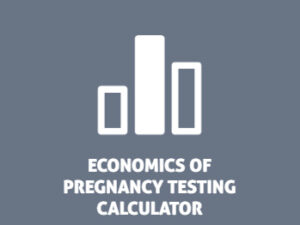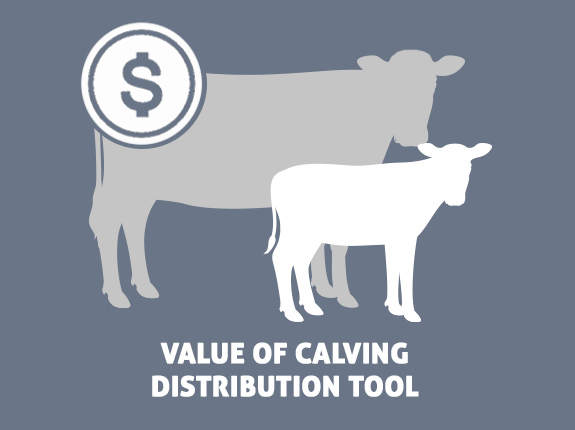Pregnancy Detection in Beef Cattle
Pregnancy detection (preg-checking) has been used in the beef industry for more than 60 years. There are many reasons for producers to preg-check including to evaluate herd and bull fertility, to help monitor herd reproductive health, to determine approximate calving dates and to help determine how best to sort cows into management groups.
Preg-checking also gives producers the opportunity to save the cost of overwintering non-pregnant (open) cows, especially in years when pasture conditions are poor, or feed is costly. Heat detection alone may not be enough to determine pregnancy as some cattle continue to show signs of ‘false heat’ after they have been bred.
| Key Points |
|---|
| Several methods can be used for testing pregnancy in cattle, ultrasound, manual palpation, and blood samples. |
| Generally, producers have three options for managing open cows: |
| -Preg-check cows in the fall and cull opens immediately |
| – Preg-check in the fall and feed open cows separately to market at a later date |
| – Do not preg-check – overwinter all cows together and cull opens in the spring after the herd has finished calving |
| The higher a producer’s feed and overwintering costs, the more favourable preg-checking and culling cows is in the fall. |
| Cull cow average daily gains (ADG) over the winter-feeding period have a significant impact on the cow’s spring value; higher weight gains over the winter result in higher spring values than low weight gains, regardless of the market price. |
| The seasonality of cow prices is a stronger driver of the economics of preg-checking than winter feed costs. |
| Consistently higher cull-cow prices in the spring can be a strong deterrent to preg-checking |
| The strategy of preg-checking and feeding the open cow group a high-energy ration for 90 days provides the greatest economic benefit to producers, when cow prices have strong seasonal increases from fall low to spring high |
| When cull cow prices drop below $0.75/lbs, many scenarios indicate that preg-checking and culling in the fall is a better option as the cost of overwintering begins to outweigh the benefit of selling heavier cull cows in the spring. |
| Preg-checking allows the opportunity to provide booster vaccines and update your Vet-Client-Patient Relationship (VCPR) with your veterinarian including herd health programs such as vaccine protocols. |
| Preg-checking allows for earlier detection of potential reproductive wrecks or a higher-than-expected open rate. |
| Preg-checking and then removing non pregnant animals from the main cow herd prevents the chance of injury that may occur when cycling cows are riding heavily pregnant cows. |
Methods of Pregnancy Detection
Several methods can be used for testing pregnancy in cattle such as, ultrasound, manual palpation, and blood samples.
Manual palpation
Palpation can determine pregnancy as early as 35-45 days by feeling the uterus and ovaries through the rectal wall. Experienced veterinarians can estimate stage of pregnancy and approximate a calving date.
Having a defined breeding season and removing bulls from a breeding pasture weeks before preg-checking will help to increase testing accuracy and eliminate the question of whether cows are open or bred fewer than 45 days before the exam.
Ultrasound
Ultrasound uses a probe to emit and receives sound waves aimed at the uterus to create an image. When sound waves contact solid tissue, like bone, they bounce back and appear white on the monitor. Sound waves pass through fluids so do not return to the probe and therefore appear black in the image. Various densities of tissue appear in shades of grey.
Ultrasound can detect pregnancy as early as 13-21 days. Pregnancy detection with ultrasound requires less manipulation of the uterus, and previous studies have shown that pregnancy loss was 1% lower in heifers that were preg-checked using ultrasound vs. manual palpation.
Compared to manual palpation, ultrasound is also more accurate at determining fetal age, can determine viability of the pregnancy, detect twins, and identify the sex of the fetus(es).
Blood samples
Detecting pregnancy with blood samples uses a lab test that detects pregnancy specific proteins. The blood sample can be taken by a producer from the tail vein then sent to a lab for analysis. Pregnancy testing through blood tests works well for producers that seldom get on-farm veterinarian visits because of limited availability in or high travel costs to their location.
Blood samples can be taken as early as 28 days and there is no risk of transferring venereal diseases between cows. Because samples must be sent to a lab for analysis, results may not be returned to producers for days or weeks. Therefore, cows will need to be brought in twice if producers want to sort cows into management groups based on pregnancy, or to cull non-pregnant cows.
Economics of Pregnancy Detection
Across Canada the percentage of producers that include preg-checking as part of their management strategy ranges from 47% to 71% depending on the region being surveyed. This number has increased since the late 1990’s but in some provinces over half of producers still do not preg-check cattle. This is often due to economics or the perceived cost savings of not having a vet do pregnancy detection. A closer look at the options for managing open cows and the associated pros, cons and resulting economics is important.
Assuming a spring calving schedule, generally producers have three options for managing open cows:
1) Preg-check cows in the fall and cull opens immediately
- Pros: Realize value of cull cows in the fall and avoid incurring costs of overwintering open cows.
- Cons: Incur vet costs and forgo the value of cull cows in spring during higher market prices.
2) Preg-check in the fall and feed open cows separately to market at a later date
- Pros: Avoids selling during the lower market prices during the fall and adds weight to cull cows before they’re sold.
- Cons: Incur vet costs, absorb overwintering costs for open cows, and supplemental feed costs.
3) Do not preg-check
- overwinter all cows together and cull opens in the spring after the herd has finished calving.
The economics of preg-checking and selling cull cows depends on:
- cull cow market price,
- the management system employed by the producer,
- feed and overhead costs, and
- veterinary costs.
More information about the economics of preg-checking is available in the Canfax Research Services factsheet.
Calculator: Economics of Pregnancy Testing Beef Cattle
To help beef cattle producers choose the most economical option for their operations, an economics of preg-checking model was developed by Ben-Ezra and Muzzin (2015). The Economics of Pregnancy Testing Calculator was developed by Canfax Research Services in 2016 and updated in 2023.
The model accounts for several factors and assists cow-calf producers in determining which of the three above options makes the most sense for their operation.
Basic and advanced versions of the calculator are available. The advanced version is recommended for producers who would like to tailor their individual on-farm cost of production and expected average daily gains when feeding cull cows as a separate group.
Learn more about the calculator in this 2023 BCRC post.
For a history of the development of the model, see this BCRC post from 2016.
See our Introduction Record Keeping and Benchmarking page on BeefResearch.ca for resources to help you keep records in order to make informed decisions on your operation.
Value of Calving Distribution
Each time a cow is not bred during a 21-day heat cycle, it can cost up to 39 lbs of weaning weight (assuming an average daily gain on calves of 1.85 lbs/day). This calculator will allow producers to see what their current calving distribution is, and what the impact on your revenue would be if they move to the industry target of 60-25-10-5, or a condensed breeding season of three cycles.
Benefits of Pregnancy Detection
Although less easily measured, there are many other benefits of having your veterinarian preg-check cattle in the fall:
• Allows the opportunity to provide booster vaccines and update your Vet-Client-Patient Relationship (VCPR) with your veterinarian including herd health programs such as vaccine protocols.
• Can detect potential concerns during palpation including abnormalities of the reproductive tract or the occurrence of twins
• Allows for earlier detection of potential reproductive wrecks or a higher than expected open rate.
• Provides an opportunity when handling animals to provide internal and external parasite control.
• Is the perfect time to do hands on body condition scoring.
• Removing non pregnant animals from the main cow herd prevents the chance of injury that may occur when cycling cows are riding heavily pregnant cows
• Gives an opportunity to make sure ear tags are still in place and legible
- References
-
Preg-Testing Cows is Easier than it Used to Be
Canadian Cattlemen, The Beef Magazine
http://www.canadiancattlemen.ca/2015/09/25/preg-testing-cows-is-easier-than-it-used-to-be/Pregnancy Checking Tips
The Beef Magazine
http://beefmagazine.com/genetics/selection-tools/pregnancy-checking-tips-1101Methods of Pregnancy Detection in Beef Cattle
North Dakota State University
https://www.ag.ndsu.edu/pubs/ansci/beef/as1632.pdfBen Ezra and Muzzin. 2015.
Feedback
Feedback and questions on the content of this page are welcome. Please e-mail us.
Expert Review
This content was last reviewed February 2022.
This content was last reviewed October 2023.

